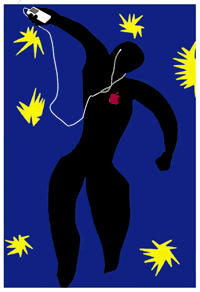Colr Pickr for Flickr
Colr pickr is a very cool mashup from KrazyDad that lets you select a color from a wheel and then instantly finds and links to a bunch of Flickr photos where that that color is dominant.
(link via eelearning)
Colr pickr is a very cool mashup from KrazyDad that lets you select a color from a wheel and then instantly finds and links to a bunch of Flickr photos where that that color is dominant.
The new issue of David Weinberger's JOHO (Journal of the Hyperlinked Organization) is available. Of particular note:
 In addition to posting virtual museum tours and interactive art educational materials, museums are increasingly making their in-house audio tours - and special audio programming - available as free podcasts. Visitors can use the podcasts to listen on site or off, and subscribers can automatically receive feeds for new shows.
In addition to posting virtual museum tours and interactive art educational materials, museums are increasingly making their in-house audio tours - and special audio programming - available as free podcasts. Visitors can use the podcasts to listen on site or off, and subscribers can automatically receive feeds for new shows.
 Ever think that your teachers or colleages were behaving a bit... um... mechanically?
Ever think that your teachers or colleages were behaving a bit... um... mechanically?In this zdnet interview, he talks briefly about technological change over the past four years, open access, power, and control. There are links to much much more, of course on his web site. (Incidentally, if you're not already familiar with CooperationCommons, you'll probably want to check it out.)
 Pelican Bay State Prisoner Donny Johnson, a lifer, makes his abstract paintings on the back of postcards using paints made from M&Ms and a paintbrush made from strands of his own hair, according to this NY Times article.
Pelican Bay State Prisoner Donny Johnson, a lifer, makes his abstract paintings on the back of postcards using paints made from M&Ms and a paintbrush made from strands of his own hair, according to this NY Times article.
Source: Kaiser Family Foundation - globalhealthfacts.org
A few items from around the blogosphere:

Some fun facts from survey results reported in this BBC article:
 It's amazing how much my thinking has changed since I characterized tagging as "chaotic and counterintuitive" in a post last October ... now I'm closer to thinking along these lines, which David Weinberger elegantly begins with:
It's amazing how much my thinking has changed since I characterized tagging as "chaotic and counterintuitive" in a post last October ... now I'm closer to thinking along these lines, which David Weinberger elegantly begins with:The narrative that tells of the first man and woman encountering the tree of knowledge focuses on its tempting fruit. But after we took the bite, we apparently looked up and got the idea that knowledge is shaped like the tree's branching structure: Big concepts contain smaller ones that contain smaller ones yet. Over the millennia, we have fashioned the structures of knowledge in just such tree-like ways, from the departmental organization of universities (liberal arts contains history and history contains ancient Chinese history) to the hierarchy of species. The idea that knowledge is shaped like a tree is perhaps our oldest knowledge about knowledge.
Now autumn has come to the forest of knowledge, thanks to the digital revolution. The leaves are falling and the trees are looking bare. We are discovering that traditional knowledge hierarchies that have served us so well are unnecessarily restricted when it comes to organizing information in the digital world.
 I seem to be thinking a lot about integration these days, and I'm now trying to find the best way (and the time) to better integrate my online self, even as I find I want more online outlets for different kinds of thoughts and work.
I seem to be thinking a lot about integration these days, and I'm now trying to find the best way (and the time) to better integrate my online self, even as I find I want more online outlets for different kinds of thoughts and work.A really on-target reply from JM of Designed to Inspire to my rant on the lame application of "constructivist" approaches:
... hand in hand with your observation is the overused and abused "group collaboration" element found in all learning experiences (from pre-school through grad school). Now, I regognize that out in the real world we all need to work together to get things done, but then why don't we have a class in 1st grade on Team Work 101 (maybe even offer a few Team Work 200 level classes in college... heck, maybe even offer a PhD in it). But, does it make sense to embed these group lessons in every learning environment?This feeds right into the discussions I'm having with the participants in my NYU classes this week on evaluation and assessment.
I sometimes wonder if "learning" of the subject matter (you know . . . the subject matter that is implied in the course title) ever occurs during some group work (busy work?) projects? Or is all that forced peer interaction just a crafty babysitting mechanism (an extended talk among yourselves gimmick)? Also, when we give our group buddy a 5 out of 5 at the end of the semester for "team work" (contributions made to the project), what do we think she "learned" about the subject matter during the process?


Geez ... Looks like I'm the last person on the internet to blog about this, but I'm happy to see that users will now be able to embed a Creative Commons copyright license directly in a Word, PowerPoint or Excel file.